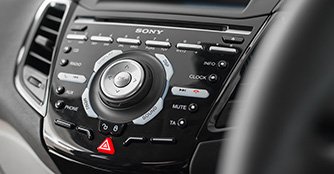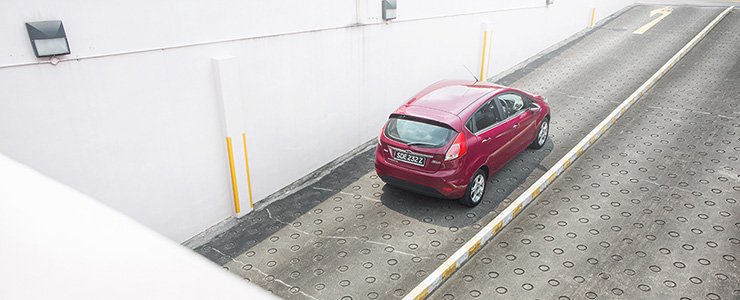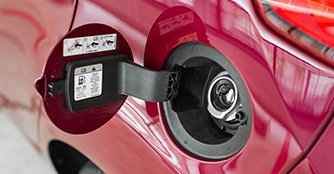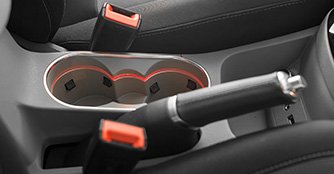Ford Fiesta 1.0 Ecoboost Titanium (A) Review
23 Oct 2014|28,094 views
Small-displacement engines are all the rage now and Ford is also getting into the game, by introducing its multi award-winning EcoBoost engine in the updated Fiesta.
Ford's popular supermini began its life in 1976. Six generations later, Ford's best-selling compact hatchback receives an improved formula that aims to turn a good car into a great one and to make Henry Ford a really proud man.
Fiesta means party in Spanish, so based on its name there's definitely got to be something really exciting about it.
Exterior
In profile, the Fiesta looks essentially the same as its predecessor with its rakish lines and bold details. Nonetheless, there has been a little bit of fiddling up in front and the most notable change is the trapezoidal grille, which is now enlarged and moved higher in line with the company's new corporate face.
 |
To complement the changes in front, a rear chrome strip and redesigned inner taillights complete the back end restyle.
With these cosmetic upgrades, the car has also grown a little. Standing at 3,969mm x 1,978 mm x 1,443mm (L x W x H), the car is now 19mm longer, 56mm wider and 10mm taller as compared to the outgoing model and this also contributes to a greater road presence than before.
 |
Interior
The Fiesta is equally attractive inside, where you'll find good quality materials with decent fit and finish.
However, the dash design still feels somewhat dated with an in-car entertainment system teamed to a tiny dashboard screen. There are also too many buttons on the centre console, which can get a little confusing at times.
Nevertheless, the instruments are bathed in a classy blue light as opposed to the brash red of the outgoing model and this helps to give a nice balance of sportiness and sophistication.
Although the car belongs to a compact class, storage is well-sorted, with an abundance of cubby holes and deep door pockets. Groceries and a couple of large suitcases are also well taken care of by the 281-litre boot space, which can be expanded to 985 litres with the rear seats folded.

Headroom is decent and there is no hint of claustrophobia for occupants. Legroom is accomodating as well, which is admirable especially for a car that measures less than four metres long.
 |
The Drive
Replacing the 1.4-litre four-cylinder engine in the previous model is the puny 1.0-litre three-cylinder EcoBoost lump that has countless accolades to its name.
Despite its downsized 1.0-litre capacity, this little engine's muscular 170Nm torque output provides confidence-inspiring overtaking pace and allows you to power up inclines that would leave some of its rivals struggling.

The powerplant is paired with a six-speed Powershift dual-clutch automatic transmission that offers quick gear shifts, particularly under mid to heavy throttle, and there's very little low-speed hesitancy that can commonly bother gearboxes of this kind.
At the same time, the downsized drivetrain also helps in the quest for fuel economy. The Fiesta is more efficient than before, claiming 20.4km/L as compared to 11.2km/L of its predecessor, although we only managed 12.8km/L during our test drive.
But more importantly, the car is a very competent and delightful one to drive. With its compact footprint, manoeuverability is a high point for the Fiesta. It is agile, fun to sling through corners and has a reactive and sharp steering. The pint-sized hatchback negotiates narrow streets well and squeezes into tight parallel parking spots with ease, making it a great city dweller.
On the roads, the ride is slightly on the firm side, but it never feels uncomfortable over bumps and ruts, and the body remains well-controlled over larger inconsistencies.

Conclusion
The upgraded Fiesta picks up where the old one left off - terrific looks, value for money and a decent helping of European engineering.
And at $118,999 (as of 10th October 2014), buyers seeking a few driving thrills and some punch can look forward to a worthy consideration, especially with the small but exciting heart of the Fiesta.
Small-displacement engines are all the rage now and Ford is also getting into the game, by introducing its multi award-winning EcoBoost engine in the updated Fiesta.
Ford's popular supermini began its life in 1976. Six generations later, Ford's best-selling compact hatchback receives an improved formula that aims to turn a good car into a great one and to make Henry Ford a really proud man.
Fiesta means party in Spanish, so based on its name there's definitely got to be something really exciting about it.
Exterior
In profile, the Fiesta looks essentially the same as its predecessor with its rakish lines and bold details. Nonetheless, there has been a little bit of fiddling up in front and the most notable change is the trapezoidal grille, which is now enlarged and moved higher in line with the company's new corporate face.
To complement the changes in front, a rear chrome strip and redesigned inner taillights complete the back end restyle.
With these cosmetic upgrades, the car has also grown a little. Standing at 3,969mm x 1,978 mm x 1,443mm (L x W x H), the car is now 19mm longer, 56mm wider and 10mm taller as compared to the outgoing model and this also contributes to a greater road presence than before.
Interior
The Fiesta is equally attractive inside, where you'll find good quality materials with decent fit and finish.
However, the dash design still feels somewhat dated with an in-car entertainment system teamed to a tiny dashboard screen. There are also too many buttons on the centre console, which can get a little confusing at times.
Nevertheless, the instruments are bathed in a classy blue light as opposed to the brash red of the outgoing model and this helps to give a nice balance of sportiness and sophistication.
The Fiesta is equally attractive inside, where you'll find good quality materials with decent fit and finish.
However, the dash design still feels somewhat dated with an in-car entertainment system teamed to a tiny dashboard screen. There are also too many buttons on the centre console, which can get a little confusing at times.
Nevertheless, the instruments are bathed in a classy blue light as opposed to the brash red of the outgoing model and this helps to give a nice balance of sportiness and sophistication.
Although the car belongs to a compact class, storage is well-sorted, with an abundance of cubby holes and deep door pockets. Groceries and a couple of large suitcases are also well taken care of by the 281-litre boot space, which can be expanded to 985 litres with the rear seats folded.
Headroom is decent and there is no hint of claustrophobia for occupants. Legroom is accomodating as well, which is admirable especially for a car that measures less than four metres long.
The Drive
Replacing the 1.4-litre four-cylinder engine in the previous model is the puny 1.0-litre three-cylinder EcoBoost lump that has countless accolades to its name.
Despite its downsized 1.0-litre capacity, this little engine's muscular 170Nm torque output provides confidence-inspiring overtaking pace and allows you to power up inclines that would leave some of its rivals struggling.
The powerplant is paired with a six-speed Powershift dual-clutch automatic transmission that offers quick gear shifts, particularly under mid to heavy throttle, and there's very little low-speed hesitancy that can commonly bother gearboxes of this kind.
At the same time, the downsized drivetrain also helps in the quest for fuel economy. The Fiesta is more efficient than before, claiming 20.4km/L as compared to 11.2km/L of its predecessor, although we only managed 12.8km/L during our test drive.
Replacing the 1.4-litre four-cylinder engine in the previous model is the puny 1.0-litre three-cylinder EcoBoost lump that has countless accolades to its name.
Despite its downsized 1.0-litre capacity, this little engine's muscular 170Nm torque output provides confidence-inspiring overtaking pace and allows you to power up inclines that would leave some of its rivals struggling.
The powerplant is paired with a six-speed Powershift dual-clutch automatic transmission that offers quick gear shifts, particularly under mid to heavy throttle, and there's very little low-speed hesitancy that can commonly bother gearboxes of this kind.
At the same time, the downsized drivetrain also helps in the quest for fuel economy. The Fiesta is more efficient than before, claiming 20.4km/L as compared to 11.2km/L of its predecessor, although we only managed 12.8km/L during our test drive.
But more importantly, the car is a very competent and delightful one to drive. With its compact footprint, manoeuverability is a high point for the Fiesta. It is agile, fun to sling through corners and has a reactive and sharp steering. The pint-sized hatchback negotiates narrow streets well and squeezes into tight parallel parking spots with ease, making it a great city dweller.
On the roads, the ride is slightly on the firm side, but it never feels uncomfortable over bumps and ruts, and the body remains well-controlled over larger inconsistencies.
Conclusion
The upgraded Fiesta picks up where the old one left off - terrific looks, value for money and a decent helping of European engineering.
And at $118,999 (as of 10th October 2014), buyers seeking a few driving thrills and some punch can look forward to a worthy consideration, especially with the small but exciting heart of the Fiesta.
Also read our comparison article on:
Ford Fiesta 1.0 Ecoboost Titanium (A) vs Volkswagen Polo 1.2 TSI DSG (A)Car Information
Ford Fiesta 1.0 Ecoboost Titanium (A)
CAT A|Petrol|20.4km/L
Horsepower
74kW (99 bhp)
Torque
170 Nm
Acceleration
10.8sec (0-100km /hr)
This model is no longer being sold by local distributor
All Used Ford FiestaThank You For Your Subscription.














































